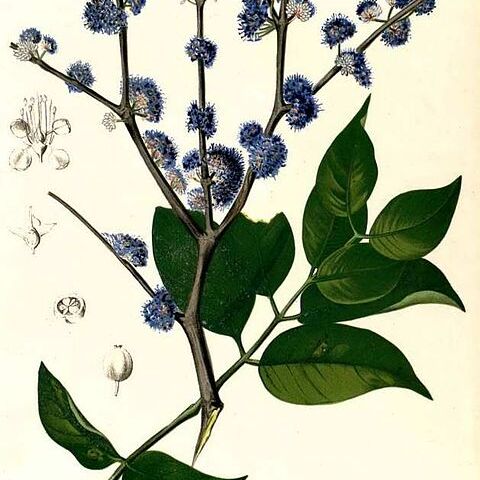Shrubs to small or medium trees. Leaves with a prominent midrib, lateral veins relatively indistinct to invisible; petiole short to very short. Inflorescences usually axillary or cauline, simple to compound cymes or reduced to umbels or fascicles, with small to very small bracts and bracteoles. Flowers 4-merous. Hypanthium usually campanulate, glabrous. Calyx lobes relatively indistinct, as small teeth or undulations, or absent, generally persistent in fruit. Petals oblong to orbicular, becoming reflexed, white, pink, blue or purple. Stamens 8, isomorphic; anthers globose, dolabriform or curved, with lateral slits; connective not prolonged, usually with a short thick dorsal appendage, ventral appendage absent, and often with a circular dorsal gland. Ovary 1-locular, the summit glabrous; ovules 2–20 on a basal or free central placenta; style filiform. Fruit fleshy, indehiscent. Seed 1 (occasionally 2), relatively large, usually globose, smooth and glossy.
Shrubs or small trees, often glabrous; branches terete or 4-sided, many-branched. Leaves petiolate or sessile; leaf blade usually leathery, pinnately veined, margin entire. Inflorescences axillary or inserted on leafless stems, cymose or umbellate. Flowers 4-merous. Hypanthium cup-shaped, campanulate, subfunnel-shaped, or semiorbicular, apex repand or shallowly 4-lobed. Petals orbicular, oblong, or ovate, often oblique. Stamens 8, equal, isomorphic; filaments as long as anthers; anthers elliptic, small, longitudinally dehiscent; connective conic, inflated, lengthened, 2-3 × as large as anthers, sometimes abaxially with a circular concave gland. Ovary inferior, subglobose, 1-celled, apex truncate, 8-sulcate, radiated; ovule 6-12, with free central placentation. Fruit a baccate drupe, often globular, apex with hypanthium forming a ring; exocarp usually succulent, 1-seeded. Seed globular, glabrous; seed coat bony; cotyledon crumpled; embryo curved.
Stamens 8, equal, sometimes 4 with abortive anthers; filaments filiform; anthers axe-shaped, with 2 anterior thecae dehiscing by 2 longitudinal slits and usually with a gland on the concave back.
Ovary 1-locular, wholly adherent to the receptacle, sunken or convex at the apex; style filiform; ovules 2–12(20), on a central placenta.
Receptacle broadly campanulate, hemispherical or cupular, with the limb ± dilated, truncate, 4-toothed or-lobed.
Flowers 4-merous, small or minute, in fascicles or in cymes forming panicle-like or corymbose inflorescences.
Trees or shrubs usually everywhere glabrous, with the young branches narrowly 4-winged, 4-gonous or terete.
Petals broadly ovate, obovate, circular-subdeltate, obtuse or apiculate, whitish or bluish.
Fruit an ovoid, globose or ellipsoid l(2)-seeded berry, crowned by the persistent calyx.
Leaves opposite, entire, longitudinally 1–3(5)-nerved, shortly petiolate.
Seeds large; cotyledons crumpled or not so.
Bracts minute.

